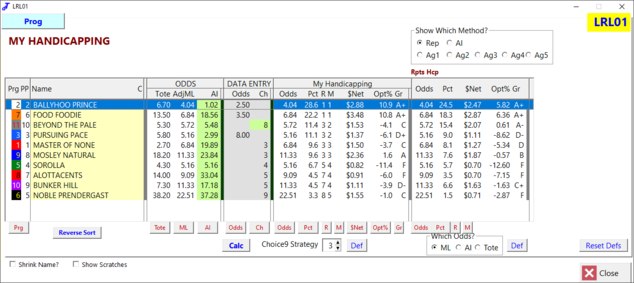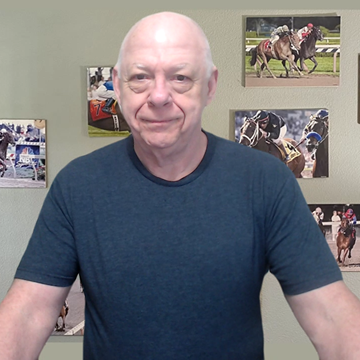Comments
-
2024 HorseStreet Pars: Some Errors Now FixedFound one more error: AQU 1 1/8 was missing.
Adding it enabled me to improve all the route pars.
All files have been updated.
Just open your order and click the link.
If anyone has lost their order link, just email KelseyatHorseStreetdotcom and she'll take care of sending you your order link. -
2024 HorseStreet Par Times are Available Now!If you ordered the 2024 Pars, the Electronic version has been emailed to you.
Most came from Kelsey, my Customer Service VA.
If you don't see it, check SPAM. -
2024 HorseStreet Par Times are Available Now!Special Note: If you pre-ordered pars they will be emailed today.
The physical book orders are at the printer and should ship on Thursday.
And, Yes. I can see there is a glitch on our store page. -
Monty Hall InquiryI think you need to get past expecting profit if any win.
If this race is a good example of the races you bet, and usually you're betting horses that go off at 5/1 and above... consider this table:
NM Races. 201-PubChWIN BETS Field1 Field2 Starts Pays Pct $Net IV PIV AvPay AvOdds AvPubC <5/1 13,869 3,745 27.0 $1.68 1.81 1.04 $6.20 2.12 1.99 Above 21,504 1,264 5.9 $1.43 0.43 0.90 $24.32 11.48 5.59 Total 35,373 5,009 14.2 $1.53 1.00 0.98
This represents a 5,000-race random sample from 2023 of all horses below 5/1.
(There were obviously 9 deadheats.)
Of the 5,000 races, 3,745 winners were under 5/1.
That's 74.9%, leaving you just 25.1% of races producing winners such as the one above.
NM Races. 201-PubCh+174-rPSR WIN BETS Field1 Field2 Starts Pays Pct $Net IV PIV AvPay AvOdds AvPubC <5/1 r 1-3 11,135 3,180 28.6 $1.66 1.90 1.04 $5.82 1.95 1.86 <5/1 above 2,734 565 20.7 $1.73 1.42 1.04 $8.35 3.11 2.53 Above r 1-3 4,653 413 8.9 $1.59 0.63 0.95 $17.86 7.70 4.38 Above above 16,851 851 5.1 $1.39 0.37 0.88 $27.46 13.18 5.92 Total 35,373 5,009 14.2 $1.53 1.00 0.98
Imagine that your horses are ALL one of the best 3 horses in the field. (Here I've used PSR as an indicator Like BRIS Prime Power.)
Above r 1-3 4,653 413 8.9 $1.59 0.63 0.95 $17.86 7.70 4.38
I question that you can consistently bet 3 horses per race, Dutch, and expect to make profit long term. -
Monty Hall Inquiry
Understand that I am not being critical here.
I'm on your side.
#1 $28 6.4 $23 #3 $21 14.20 $11 #10 $10 5.30 $26
So, you bet $10 on the winner and should have bet $26.
Do you see that Dutching from a poorly estimated tote doesn't work?
Consider that 74% of all winners are bet down from their GATE ODDS, while the losers go up.
It does NOT average out!
I believe that if you play a couple of days of races and track how you bet vs. how you should have bet and you will see that this is the norm. If you are constantly seeing your winners' odds going do and your loser's odds going up, then you know your betting strategy is not sustainable.
You cashed a ticket but squandered a chance to make big money and basically broke even instead of winning $100.
Consider Howard Sartin's old approach with 2-horse betting.
He advocated a 60-40% split, with 60% on the low odds horse and 40% on the higher odds.
Now, consider the stat that I offered where I said that 74% of winners are bet down from their gate odds and the losers are bet up.
That's equivalent to saying, "I'm doing it backwards."
So what if you REVERSED it and played an ANTI-DUTCH?
WHAT?
How does that work?
Consider your original bet in the race: $60.
So, each horse gets the DIFFERENCE between $60 and his bet.
Let's pretend that's how we split the money.
Total = $121#1 $28 becomes $32 #3 $21 becomes $39 #10 $10 becomes $50
Use THOSE BETS to divide the money.
#1 $28 becomes $32 32 / 121 x 60 = $16 #3 $21 becomes $39 39 / 121 x 60 = $19 #10 $10 becomes $50 50 / 121 x 60 = $25
What do you think? -
Monty Hall InquiryFinished #10/3/6. The Even money favorite #8 was 4th. Wagered $60.00 and returned $63.00. — Jim Pommier
Questions
1. How did you split the money?
2. Why did you do it that way? -
Monty Hall Inquiry
This has the potential to be a very worthwhile conversation, but it really needs to be an interactive conversation as opposed to a Dave Lecture.
Some Basic Questions to Start
1) Are you interested in applying the Monty Hall approach to your 3 contenders?
2) Do you want to HANDICAP your 3 contenders down to a single play?
3) Do you want to bet all 3 horses in some sort of Dutch? -
Which Tracks Are Most Handicapable?
Ah... You're "Autumn Lotus" on PA!
Read that other post I made in your other thread on PA yesterday. That's where the meat of winning can be found. But most people would rather not work so hard.
How People Handicap (my reply on PA) -
Which Tracks Are Most Handicapable?
PEN & CT are most definitely in the list.
Go to the alpha list and you can find them easily.
All the tracks are there. -
The deTerminatorPS: In Chaos races, the AI often suggests how to handicap the race, when to do NO HANDICAPPING (yes, that's a thing), and sometimes even suggests who to put money on.
-
The deTerminatorWhat makes this section of the program so neat is that there are so many ways to get OPINIONS & ADVICE from the AI.
For example, something that gets displayed this week is THE CHAOS METER, which PREDICTS the CHANCES that the race will be CHAOTIC.
This is NOT based upon things like field size, how many FTS, etc. In other words, it is not based upon "THERE'S NOT MUCH INFO IN THIS RACE, SO THE PRICE SHOULD BE HIGH."
It is based upon the likelihood that THE PUBLIC'S HANDICAPPING WON'T WORK or HOW CONFUSED THE PUBLIC WILL BE in this race, and is TOTALLY AI DRIVEN.
This will rock the world of tournament those who play tournaments, longshot, or focus on multi-race bets. -
The deTerminator
All of that makes logical sense.
However, the ALL CH choice should really have a TOP HORSE with your odds. (Odds meaning an easy way to enter "hit rate.")
<This screen is still evolving a bit.>

About this screen...
HEADINGS OF SECTIONS
ODDS
There are currently 3 sources.
1) Tote Board - (Could be scraped or manually entered)
2) AdjML - Adjusted Morning Line (Morning Line adjusted to the right Booking Percents for this track.
3) AI - This was generated by the AI.
note: Everything green was generated by the AI.
DATA ENTRY
This is where you enter your opinion of the horses chances.
I set 3 horses to have odds (probs) - #2, #7, #3
The method of my entry was a straight calculation of Pct=1/(odds+1). Doesn't have to be that way.
Look at #1 - Master of None.
Think of a "3" under "choice" as "should run like a 3rd choice in this race."
The AI has a hand it modifying that "In this Race" part.
See the #8 in the CH column?
That means, "Please use the AI to tell me what this horse's percent should be."
Notice it is green indicating the AI's involvement..
MY HANDICAPPING
This section is the MATHEMATICAL RESULT of taking the calculating the DATA ENTRY section by using the "CALC" button.
RPTS HCP
She the "Show Which Method" at the top?
By clicking "Rep" it populated that section with the output of REPORTS THAT YOU CREATED and turned on for handicapping.
(Section should really be called "Which Method")
Depending upon WHICH METHOD is chosen, that title will change to AI or one of the Agents. -
The deTerminatorI just finished the most important section in the entire program.
This is where the user gets to enter THEIR handicapping for each horse.
DeTERMINATOR is designed to be an INTERACTIVE ADVISOR in the handicapping process. That means you must be able to enter your own opinions, compare them to the AI, and even COLLABORATE with the AI.
Well, maybe "finished" is the wrong word because I will be writing collaboration functions for several more days.
But getting the data in was really a big deal.
Think of it this way... Calculations depend upon probabilities. But the only handicappers I know of who actually work with probabilities are those using a very rigid tool that says, "Horse #1 is 27%."
Get this...
Imagine you have an 8-horse field.
You have strong opinions about the 1,2 and 3 so you use the ODDS column:
1: 2.0/1
2: 3.0 /1
3: 2.5/1
You think the 4 & 5 are like 4th choices, so you use the CHOICE column.
4: 4
5: 4
(Note: If you entered actual odds for a horse, it will not use the CHOICE column. Instead, it locks your odds in.)
You think everyone else is just a crazy longshot, so you leave the 6,7,8 blank. The engine will take care of those.
That's how you get your picks in.
Then the engine converts the ODDS and CHOICES to percentages.
Then the fun starts.
BTW, CHOICES column goes from 1 to 5, but you can also enter an "8."
if you enter an "8" in the CHOICE it has the AI generate the percentage for that horse based upon what the public opinion SHOULD BE based upon the training process.
Remember that any horse you enter odds for will never change. Only the others will change - based upon the strengths you entered.
There are more tools. -
I Now completely [Understand]The idea is to make it SIMPLER instead of more complex.
(BTW, nobody actually USES 4,000 factors, right? Or even 400.)
You accomplish that by constantly working to slim down your data set.
First, you have to actually HAVE a data set. -
EARLY SPEED SERIES: Episode 6No.
While winning margin does make a small difference, it is not what people would expect.
Well, perhaps I should ask what you'd expect it to mean first.
LOL -
WHO ARE YOU?I don't teach coding.
But I am willing to discuss strategy for accomplishing what you have in mind.
Dave Schwartz

Start FollowingSend a Message
